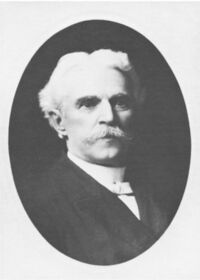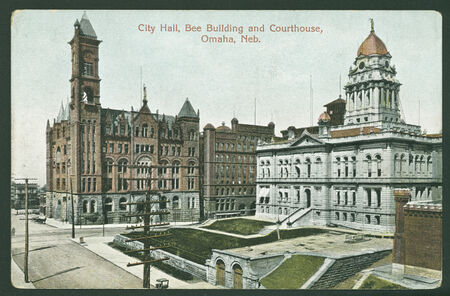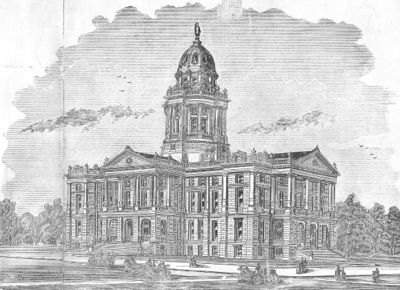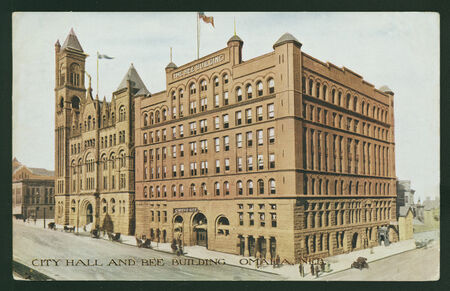Elijah E. Myers (1830-1909), Architect
D.B.A.: E. E. Myers, Architect, and E. E. Myers & Son, Architects
Elijah E. Myers was born in December of 1830 in Pennsylvania.[11][a] He was listed as a "Master Carpenter" in Philadelphia in the U. S. Census of 1860. He soon relocated to Springfield, Illinois, where he appeared in city directories as an architect by 1863 and was advertising in newspapers as "Architect & Superintendent" later in that decade.[12][14]. Selected in a design competition as architect of the Michigan State Capitol in 1871, Myers relocated to Detroit and that remained his residence for the rest of his life. He designed numerous major projects, especially public buildings, throughout the U. S. and even in Mexico and Brazil. His designs were chosen for the capitols of Michigan (1871-1879), Texas (1881-1886), Idaho Territory (1885), and Colorado (1885-1886).[13] Myers and his wife Mary had four children by 1880.[a] His son George W. partnered with him as E. E. Myers & Son.[5][6] E. E. Myers died in Detroit in 1909.[7] The broad scope of projects in which Myers was involved is well-documented.[f] His lesser-known Nebraska efforts are the focus of this page.
This page is a contribution to the publication, Place Makers of Nebraska: The Architects. See the format and contents page for more information on the compilation and page organization.
Contents
Educational & Professional Associations
1863-1870: architect, Springfield, Illinois.[12]
1871-1885: architect, Detroit, Michigan.[5]
1886-1909: architect and partner with son George W. as E. E. Myers & Son.[6][13]
Nebraska Buildings & Projects
Douglas County Courthouse (1885), Omaha, Nebraska.[9][c]
Proposal for Omaha City Hall (1886-1888), Omaha, Nebraska.[8][d]
Proposal for Lancaster County Courthouse (1887-1888), Lincoln, Nebraska.[4][e]
Douglas County Hospital (1887-1890), Omaha, Nebraska.[2][3][g]
Bee Publishing Company Building (1887-1889), NW corner of 17th & Farnam, Omaha, Nebraska.[10]
Notes
a. Various sources provide Myers' year of birth as 1830, 1831, or 1832. His Michigan death certificate and his gravestone both indicate 1830, so that date is chosen here. For further confusion, his birthday is typically given as Dec. 22, while his death certificate lists 12/29/1830.[11] The 1870 census lists Elijah and Mary Myers in Springfield, Illinois with a son George and a daughter Julia, ages 6 and 3, both born in Illinois.[12] The 1880 Census lists five children, but includes an older "son," Joseph M. (age 24 and an architect) as well as George W. (age 16, "at school").[5] No Joseph Myers, architect, is apparent in the Detroit city directories of the late 1870s or early 1880s, nor was Joseph listed with the family in 1870. Perhaps Mary and Elijah had their first child when she was 16 years old, Joseph may have been a relative but not a son, or possibly the 1880 census-taker made an erroneous entry. (E.F.Zimmer)
b. According to sources obtained by Valerie Marvin, Michigan State Capitol [3], Myers may also have designed the Omaha City Hall, Douglas County Courthouse, and Omaha City Jail at about the same time (late 1880s).
c. Omaha Daily Bee reported in May 1885 that the Douglas County commissioners adopted a resolution "That the new court house being completed and accepted by the county commissioners...the thanks of the county of Douglas are due, and are hereby tendered, E. E. Myers, Esq. of Detroit, Mich., for his skill in preparing and furnishing to the county complete plans and specifications...and for his close attention to the work as it progressed, and the assistance and aid he has so ably and cheerfully rendered to the commission..."[9]
d. Early in 1886, Omaha Daily World noted that Myers (described as the architect of the Douglas County Courthouse) was in the city, arriving from Denver where his visit was connected with the new Colorado State Capitol. He was said to be ready to complete plans for a new City Hall for Omaha with just a day or two of work. In July of 1887, the chairman of the board of public works of Omaha was reportedly incensed that Myers had not made himself available to prospective bidders on the City Hall project. The basement was then under construction, with funds ($25,000) provided by the school district, to secure one floor of the building for the school district's use. A note in the Nebraska State Journal of August 20, 1887, cited Omaha World newspaper in questioning the accuracy of Myers' estimate of $190,000 as the maximum cost of the Omaha City Hall, decrying "the methods of this lobbyist architect. If the county hospital, for which he is also to furnish plans, costs within the amount of his estimate, or within $50,000 of it, it will be the first time that this man has kept faith with the people." The City Council terminated Myers' contract in February 1888 based on a clause allowing cancellation if Myers' plans could not be built for $100,000, as bids indicated the cost would be at least double. Instead Omaha's iconic City Hall as built in 1889-1891 and demolished in 1966 was designed by Omaha architects Fowler and Beindorff.[8]
e. The commissioners of Lancaster County, Nebraska toured courthouses in Indiana, Illinois, Michigan, Iowa and Ohio prior to July of 1887, when they reviewed proposals from six architects for a Lancaster County courthouse. Three Nebraska architects (Placey of Lincoln, Ellis of Omaha, and Hodson of Omaha) and three out-of-state architects (Myers of Detroit, G. W. Bunting of Indianapolis, and Schwage & Nichols of Kansas City) made up the pool of proposals. Myers’s proposal was initially accepted, then was rejected due to bids exceeding the bond election figure. A design of F. M. Ellis of Omaha, Nebraska, was subsequently chosen and built.[4]
f. In an insightful article on Myers' design of the Texas State Capitol and his subsequent firing by the Commissioners carrying out that project, Paul Goeldner provides a very useful introduction to Myers' strengths and weaknesses as a professional architect. (Myers was also terminated from the Colorado Capitol project, well before construction was completed.) Goeldner points out: "Several important buildings of Myers's design have survived to prove his ability as an architect. They include state capitols in Michigan, Texas, and Colorado; courthouses in Macomb, Carlinville, and Galesburg, Illinois; the Richmond City Hall; and the Central Methodist Episcopal Church in Lansing. Their architect was a talented, dishonest, hard-working, spiteful, clever, unbalanced, self-assured, self-destructive hypochondriac whose story must be pieced together from fragments. He will always be somewhat mysterious, evasive, and much more interesting than many of his more conventional contemporaries."[13]
g. Superintendent Shane of the Douglas County Hospital clashed sharply with Myers and eventually resigned in frustration during construction of the hospital. Shane leveled a broadside at Myers in Omaha Daily Bee of March 3, 1889, explicitly charging the architect with incompetence, unresponsiveness, and bribery. When the building was declared completed by the contractors, Myers was unresponsive to requests to inspect it and advise the county commissioners on whether they should accept it. Similar controversies colored many of Myers' projects, while he was also extolled by various clients.[2][13]
References
1. Henry F. Withey and Elsie Withey, Biographical Dictionary of American Architects (Deceased) (Los Angeles: Hennessey & Ingalls, Inc., 1970), 436.
2. "April 2: Communication from E. E. Myers & Son relative to plan of new county hospital, filed." Omaha (Nebraska) Daily Bee (August 19, 1887), 5; "Myers Wants Shane's Head...The Architect Becomes Angry and Asks the County Commissioners to Request Mr. Shane to Resign, Etc., Etc.", Omaha (Nebraska) Daily Bee (February 22, 1889) 5; "Mr. Meyers [sic] Receives a Little Reminder That He Is Too Slow to Suit Douglas County," Omaha Daily Bee (March 17, 1889), 2; Omaha Daily Bee (April 9, 1889), 7; "He Reserved His Fire. Mr. Shane Resigns and Puts In a Few Extras. He Does Not Like Mr. Meyers [sic]. And Pulls the Cork From Vials of Wrath Which He Had Been Preserving Intact For Many Moons," Omaha (Nebraska) Daily Bee (March 3, 1889), 6; "Myers Will Be Superseded," Omaha (Nebraska) Daily Herald (April 20, 1889), 1; "The New County Hospital, It Will be Officially Inspected by the Commissioners Tomorrow. Where is Architect Meyers? A Large Bill of Extras to be Presented by the Contractors," Omaha (Nebraska) Daily Bee (January 5, 1890), 3.
3. Valerie Marvin, Michigan State Capitol, email communication to Michael Smith, Nebraska State Historical Society, July 5, 2006; and email response from D. Murphy, July 6, 2006.
4. "County Commissioners' Report," (Lincoln) Nebraska State Journal (July 19, 1887), 4; "To Contractors" (call for sealed proposals), (Lincoln) Nebraska State Journal (October 26, 1887), 6; "Level and Square. The Corner Stone of the County Capitol," (Lincoln) Nebraska State Journal (November 2, 1888), 6.
5. Ancestry.com and The Church of Jesus Christ of Latter-day Saints. 1880 United States Federal Census [database on-line]. s.v. "Elijah Myers." Lehi, UT, USA: Ancestry.com Operations Inc, 2010. 1880 U.S. Census Index provided by The Church of Jesus Christ of Latter-day Saints.
6. 1900 United States Census, s.v. “Elijah E. Myers,” Detroit, Wayne County, Michigan, accessed through HeritageQuestOnline.com.
7. "Col. Elijah E. Myers." (obituary), The New York Times (March 6, 1909).
8. "Next Year Sure. Architect Myers and One of His Friends on the New City Hall," Omaha (Nebraska) Daily Herald (January 8, 1886), 1; "Improvements In The Way of Paving, Grading, Etc.," Omaha (Nebraska) Daily Herald (July 25, 1887), 1; "The City Hall Construction. [from] Omaha World," (Lincoln) Nebraska State Journal (August 10, 1887), 2; "Wiseacre [Councilman] Counsman," Omaha (Nebraska) Daily Bee (October 15, 1887), 4; "Meyers [sic] Loses His Head. The Council Dissatisfied WIth HIs Work as City Hall Architect. His Contract Annulled and HIs Plans Rejected--Brennan & Co. Ordered to Cease Work," Omaha (Nebraska) Daily Herald (February 7, 1888), 7; "The Council Powerless. Its Schemes defeated by a Forgotten Ordinance for City Hall Construction. The site of the Structure Fixed by Popular Vote," Omaha (Nebraska) Daily Herald (February 19, 1888), 8; "To Endure for Centuries. Laying of the Massive Corner-Stone of the New City Hall...and a Description of the Beautiful Pile," Omaha (Nebraska) Daily Bee (June 20, 1890), 5.
9. "A Few Surprises," Omaha (Nebraska) Daily Bee (May 29, 1885), 5.
10. "City Affairs. The Council Orders the City Hall Foundation Lowered," Omaha (Nebraska) Daily Bee (October 20, 1887), 4.
11. Ancestry.com. Michigan, Death Records, 1867-1950 [database on-line]. s.v. "Elijah E. Myers." Provo, UT, USA: Ancestry.com Operations, Inc., 2015; Ancestry.com. U.S., Find A Grave Index, 1600s-Current [database on-line]. s.v. "Elijah E. Myers." Provo, UT, USA: Ancestry.com Operations, Inc., 2012.
12. Ancestry.com. 1860 United States Federal Census [database on-line]. s.v. "Elijah E. Myers." Provo, UT, USA: Ancestry.com Operations, Inc., 2009. Images reproduced by FamilySearch; and Ancestry.com. 1870 United States Federal Census [database on-line]. s.v. "Elijah E. Myers." Provo, UT, USA: Ancestry.com Operations, Inc., 2009. Images reproduced by FamilySearch.
13. Paul Goeldner, "The Designing Architect: Elijah E. Myers," The Southwestern Historical Quarterly (92:2, October 1988, 271-288).
14. "E. E. Myers, Architect & Superintendent, Springfield, Ills.," (Bloomfield, Illinois) Pantagraph (December 13, 1867), 2.
Page Citation
E. F. Zimmer and D. Murphy, “Elijah E. Myers (1830-1909), Architect,” in David Murphy, Edward F. Zimmer, and Lynn Meyer, comps. Place Makers of Nebraska: The Architects. Lincoln: Nebraska State Historical Society, February 11, 2018. http://www.e-nebraskahistory.org/index.php?title=Place_Makers_of_Nebraska:_The_Architects Accessed, April 19, 2024.
Contact the Nebraska State Historic Preservation Office with questions or comments concerning this page, including any problems you may have with broken links (see, however, the Disclaimers link at the bottom of this page). Please provide the URL to this page with your inquiry.



